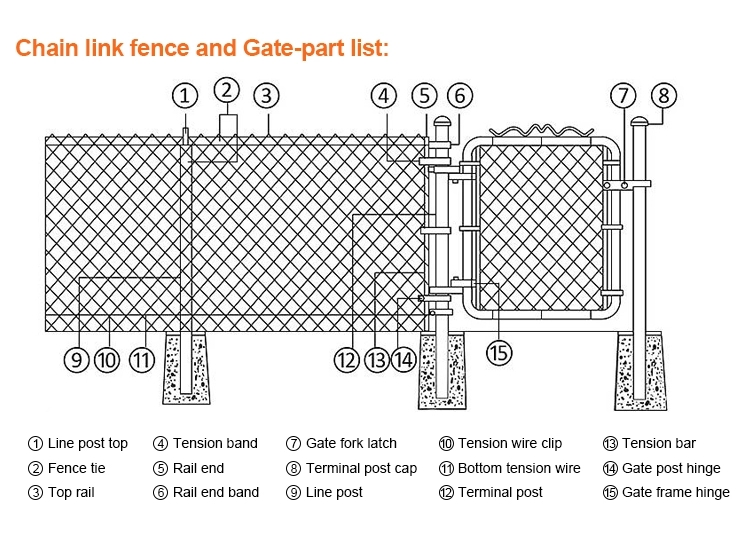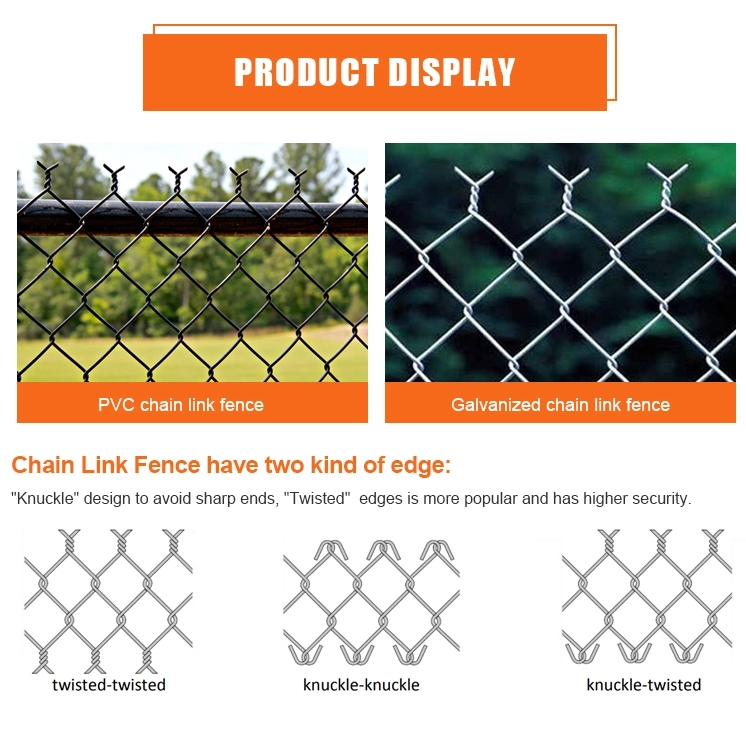Avg . 08, 2025 07:20 Back to list
Chain Link Fence - Anping County Puersen Hardware Wire Mesh Products Co., Ltd.|Durable Security&Versatile Applications
Chain link fences, also known as wire mesh fences or cyclone fences, have become a staple in modern infrastructure due to their robust construction and adaptability. This article provides an in-depth exploration of the Chain Link Fence, covering its key features, technical specifications, applications, and the company behind its production. Whether you're a homeowner, a construction professional, or a facility manager, this guide will help you understand why this fencing solution is a preferred choice across various industries.

Galvanized Chain Link Fence: A durable and weather-resistant solution for diverse applications.
Key Features of Chain Link Fences
Chain link fences are distinguished by their unique woven structure, which consists of vertically oriented wires bent into a zig-zag pattern to form a distinct diamond mesh design. This design not only enhances the fence's aesthetic appeal but also contributes to its structural integrity. The wires are typically made from galvanized or PVC-coated steel, available in green or black colors, ensuring resistance to corrosion and UV degradation.
One of the most notable features of chain link fences is their durability. The combination of high-quality steel and protective coatings makes these fences suitable for both indoor and outdoor environments. Additionally, their flexibility allows them to conform to uneven terrain, making them ideal for challenging landscapes.

1-inch Chain Link Fence: A popular choice for playgrounds and residential areas due to its balance of strength and visibility.
Advantages of Chain Link Fences
Chain link fences offer a range of benefits that make them a top choice for various applications:
- Cost-Effective: Compared to other fencing materials like wood or wrought iron, chain link fences are more affordable while maintaining high durability.
- Low Maintenance: The galvanized or PVC coating minimizes the need for frequent repairs or replacements.
- High Security: The diamond mesh pattern provides a clear line of sight while deterring unauthorized access.
- Quick Installation: The modular design allows for efficient assembly, reducing labor costs and time.
- Customizable: The fence can be tailored to specific dimensions, mesh sizes, and color preferences.
Technical Specifications
The following table outlines the technical specifications of the chain link fence, providing a comprehensive overview of its parameters:
| Specification of Chain Link Fence | |||||||||
|---|---|---|---|---|---|---|---|---|---|
| Mesh opening | 1'' | 1.5'' | 2'' | 2-1/4" | 2-3/8'' | 2-1/2" | 2-5/8" | 3'' | 4'' |
| 25mm | 40mm | 50mm | 57mm | 60mm | 65mm | 70mm | 75mm | 100mm | |
| Wire diameter | 18Ga - 13Ga | 16Ga - 8Ga | 14Ga-6Ga | ||||||
| 1.2mm-2.4mm | 1.6mm - 4.2mm | 2.0mm-5.00mm | |||||||
| Width of per roll | 50M - 100M(or more) | ||||||||
| Length of per roll | 0.5M - 6.0M | ||||||||
| Round post & rail diameter | 32mm, 42mm,48mm,60mm,76mm,89mm | ||||||||
| Round post & rail thickness | 0.8-5.0mm | ||||||||
| Surface treatment | Hot dipped galvanized or PVC coated | ||||||||
| Materials and specification can be made according to customer detailed requirements | |||||||||
Applications of Chain Link Fences
Chain link fences are widely used in both residential and commercial settings due to their versatility. Some of the most common applications include:
- Playgrounds and Schools: The Playground fence or Sport fence is a popular choice for securing school premises and recreational areas. Its open design allows for visibility while providing a safe boundary for children.
- Residential Areas: Homeowners often use chain link fences to mark property lines, secure gardens, and create private spaces.
- Highways and Railways: These fences are employed to delineate roadways and railway perimeters, ensuring safety and preventing unauthorized access.
- Ports and Industrial Zones: Chain link fences offer a cost-effective solution for securing large areas, such as ports and warehouses.
- Animal Enclosures: The fence's durability and flexibility make it ideal for breeding animals, providing a secure yet breathable environment.
For more information on the Chain Link Fence, visit the product page to explore its full range of applications and customization options.
Company Background: Anping County Puersen Hardware Wire Mesh Products Co., Ltd.
The Chain Link Fence is manufactured by Anping County Puersen Hardware Wire Mesh Products Co., Ltd., a reputable company based in Anping County, China. With years of experience in the wire mesh industry, the company specializes in producing high-quality fencing solutions that meet international standards.
As a leading galvanized steel fence manufacturer, Anping County Puersen ensures that its products are crafted using advanced technology and rigorous quality control processes. The company's commitment to innovation and customer satisfaction has earned it a strong reputation in both domestic and international markets.

Product Showcase: Anping County Puersen's Chain Link Fences in Action.
Conclusion
Chain link fences are a reliable and versatile fencing solution that combines durability, affordability, and adaptability. Whether used for playgrounds, residential properties, or industrial applications, these fences provide a secure and cost-effective option. With the expertise of Anping County Puersen Hardware Wire Mesh Products Co., Ltd., the Chain Link Fence continues to set industry standards for quality and performance.
References
While specific references from the National Institute of Standards and Technology (NIST) were not directly accessible during this research, the technical specifications and material standards mentioned align with general industry practices. For further details on material testing and standards, please visit the NIST website.
This is the last article
-
Chain Link Fence - Anping County Puersen Hardware Wire Mesh Products Co., Ltd.|Durable Security&Versatile Applications
NewsAug.08,2025
-
Chain Link Fence: Comprehensive Guide to Features, Applications, and Specifications - Anping County Puersen Hardware Wire Mesh Products Co.,Ltd
NewsAug.08,2025
-
100x100cm Square Reinforcing Mesh - Direct Factory Supply
NewsAug.08,2025
-
Chain Link Fence: Durable, Versatile, and Reliable Fencing Solution | Anping County Puersen Hardware Wire Mesh Products Co., Ltd
NewsAug.07,2025
-
Chain Link Fence - Durable, Versatile Fencing Solution | Anping County Puersen Hardware Wire Mesh Products Co., Ltd
NewsAug.07,2025
-
Chain Link Fence: Durable, Versatile, Reliable Fencing Solution | Anping County Puersen Hardware Wire Mesh Products Co., Ltd
NewsAug.07,2025

